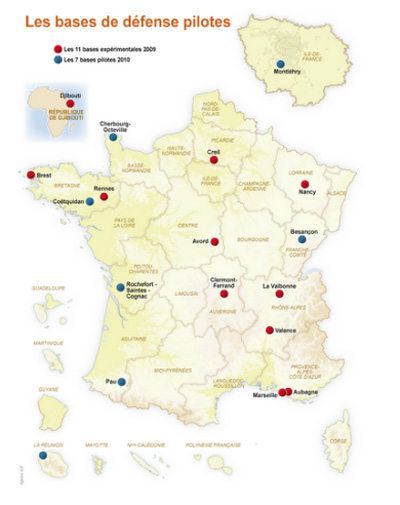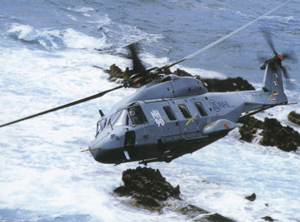Logistics on the Front Line
A few months ago, SLD sat down with General Jean-Pierre Bansard, in charge at the time of Logistics Organization within the MoD Chief of Staff, in order to gain a better understanding of the evolution of French support and logistics in light of the many undergoing reforms and the mutation of the battlefield.
This is the second of a three-part series previously published in French as a single article in ”Soutien Logistique Défense” in October 2009.
4. [SLD] What lessons can be drawn from the measures already implemented, such as improved Full In Service Support (MCO for “maintien en condition opérationnelle“ in French), increasing outsourcing, or existing restructuring, e.g. the creation of the CSFA (Commandement du soutien des forces aériennes, i.e. Air Assets Support Command) and the SIAé (Service Industriel de l’Aéronautique, i.e. Aeronautics Industrial Support Service)? Are these measures compatible with the upcoming new reforms?
[General Bansard] Despite the fact that the numerous audits, which were done in the framework of the RGPP about the support units, were conducted by outside experts, such a process managed to take into account the studies and reviews launched prior to the RGPP. Indeed, the adaptation and rationalization efforts have been a constant concern within the armed forces’ support units and many of the leads followed by the RGPP audit teams are in the wake of the work achieved in the past years by the armed services and the support services.
As a result, the ongoing reforms are for the most part fully compatible and consistent with the evolutions already underway. In fact, the RGPP can be considered as the main catalyst for speeding up the pace of reforms already engaged and for launching reforms considered at the time, but not yet fully on track.

Nearly all of the forty or so ongoing reform projects taking place within the ministry of defense have a functional nature, as they all aim at rationalizing and optimizing the support functions.On the other hand, the creation of defense bases is by nature organizational. The goal is to put support capabilities in common on a territorial and joint basis, since all MoD structures physically located near the defense base are to be supported by the “Defense Base Support Group” (GSBdD or “Groupement de Soutien de la Base de Défense” in French), which brings together all common management and support means.
The creation of defense bases can therefore be described as a transverse cross-cutting reform and the coherence of the overall process of reform must be assessed within such a context, which is not an easy task.
This new organization directly impacts in particular on the deployable support assets. Indeed, when deployable units are located on a defense base, they share their support capabilities within the GSBdB on a joint basis, but when these units have to be sent on an operational mission, these capabilities need to be rendered to them in full: this is for instance true as far as the treasurers are concerned, who will now be one per GSBdD as opposed to one per regiment, but such an evolution concerns all military support functions. To build our capability model, the basis has always been a theoretical ternary rotation cycle for military personnel (“one on the ground, one returning from it, and one getting ready to go”); in reality, the ratio tends to be more 3.5, nay even 4 to 1, in order to face unavailability, training imperatives and other hazards. The “mutualization” of support capabilities is to lead to their actual reduction, which means that, as a result, the GSBdD is not always in a position to provide all the necessary deployable capabilities on its own. This generates therefore a support capabilities maneuver on a joint level, either via a system of rotation among the defense bases, or via the resort to reserves, but also most certainly, via the hiring of temporary staff, such as veterans.
6. Does the economic crisis have any tangible impact on the current developments (either positive such as speeding up certain aspects of the reform, or negative such as the shrinking of the supply base)?
It is a bit too soon to comment on the effects of the crisis. Indeed, one must refrain from confusing the “noise” (i.e. the short-term analysis of the signs) and the trend. Military planners always work on a ten-year period (the outlook of the White Paper is 2020), the military program law is based on six-year time-frame, and even budgetary forecasts are now three-year based. It would therefore be rather risky to try to extrapolate on the past months trends over the long run.
Military logisticians must display self-control, calm and levelheadedness. They must be able to take a step back from current events and put them into perspective, because logistics systems are by nature endowed with inertia: they must be driven like oil tankers rather than race trimarans. If logisticians were to base their actions on the immediate interpretation of daily events, military logistics would become about as reliable as the stock exchange market.
Reading scholarly and well-documented reports on the current economic crisis, I cannot help but remembering similar reports written when the oil prices ranged over 140 dollar a barrel and which recommended I urgently put in place financial dispositions in order to face an unavoidable rise over 200 dollar a barrel. My instinct was to wait and I am glad I did, since today I get other well-documented reports, coming from the same organizations, which explain how to manage the cost of oil supposed to remain under 40 dollar a barrel for a while.
So, as far as the impact of the economic crisis on the MoD’s reform is concerned, the only thing one can say for now is that the higher credit rates for business make any form of public-private partnership (PPP for “Partenariat Public-Privé ” in France, PFI for “Public Finance Initiative” in the UK) more challenging, and that the shrinking of the industrial base does not facilitate the defense conversion process underway to accompany the suppression of MoD’s jobs. It would be however a bit presumptuous to translate such a statement into the longer term, given, among other heavy trends, the demographic factor: baby-boomers (such as myself) will indeed soon – and massively – pave the way for younger generations, especially in small and medium-size enterprises.

7. What is your feeling about the impact of the new generation of equipment on support and logistics?
The least one can say is that this question is complex and is subject to many controversies. As I am nearing the end of a long career of logistician, I have been in a position to attend the early phase of many military programs now in production (Leclerc, Tigre, NH90, VBCI and to a lesser extent Rafale). For each of these programs, I can assure you that the reduction of MCO costs has always been part of the military specificities. No matter how amusing it may seem today, the MCO costs reductions were indeed emphasized in the Total Ownership Cost (TOC) assessment as a major argument to speed up the renewal of the fleet.
We are in fine witnessing an explosion in overall MCO costs per hour of service or per flight hour. One may therefore wonder about the assessments done at the time regarding support in the context of the process of integrated logistics support, which primarily benefited these equipments. There are of course multiple reasons behind this, and one should refrain from hazardous comparisons. One flight hour of Tiger and Rafale delivers an operational performance far superior to a flight hour of Gazelle or Mirage 2000. The same observation is valid for the VBCI compared to the VAB or the NH90 compared to the Puma.
One must however acknowledge that the weight of the MCO in the TOC of modern arm systems is constantly growing, whereas the forecast twenty years ago predicted a substantial reduction. Are the causes linked to the tendency, classic in many military programs to over-commit, or does this signal a much deeper phenomenon? Probably a bit of both.
In my view, the frantic technological race is definitely part of the determining factors lying behind the MCO costs’ evolution, especially because of the frustrating cortege of obsolescence it generates and the costly updates which go with it. However, the search for technological excellence is consusbtantial with operational performance, which is not only indispensable when facing the enemy, but also when it comes to competition in regard to arms export – which one cannot do without.
Nonetheless, the current geostrategic context seems to favor a diversification of the fleet, in which could co-exist high-tech equipment providing a high level of performance fitting the most demanding deployments on the one hand, a more rustic fleet with more limited capabilities, but sufficient for easier operations, on the other hand. It is certainly a path worth exploring, knowing that there is a gap between the theory and the implementation: like haute cuisine, it is all a matter of mixing and matching the right ingredients in the right proportions.
Is France heading towards a reform of the acquisition process, which would allow an end-to-end approach to military programs, while integrating support and logistics requirements from the outset of their conception?
The answer is an unequivocal YES. However, it is a bit of a practical joke, since this question has been on the table for more than 20 years (if not more), and the answer has systematically been yes. But in spite of that, we still have not found the magical potion, which will perform miracles, such as a free-ride…
The Chief of staff and the MoD’s Acquisition service (known as DGA in France, for “Délegation Générale de l’Armement“) work nevertheless tirelessly and hand-in-hand on the establishment of Integrated Program Teams (EDPI, for “équipes de programme intégrées“). These EDPIs would follow up a program throughout its life-cycle (from its conception till its retirement) and would include, besides the program’s director and the Chief program officer, a third official in charge of MCO. In the past, the responsibilities of the program’s director and the Chief program officer would split once the equipment would become operational. Nowadays, the trend is to associate a tripartite entity systematically including a support and logistics expert (MCO, maintenance and integrated logistics) to the conduct of a program throughout its life-cycle.
The implementation of these new EDPIs is going to be experimented on about ten programs, selected so that they represent an accurate sample and help validate the concept, while contributing to the definition of the best processes.
Of course, if there is an area where experimentation needs to be conducted without taboo nor prejudice, it is when dealing with the role of industries as far as MCO is concerned. Many leaps ahead have been achieved, but there is still a long way to go on a path filled with obstacles – a path one needs to walk upon with circumspection and pragmatism without being too dogmatic or simplistic. For genuine partnerships between the armed forces and industries to emerge and last, it is crucial to build them on the basis of a win-win relationship and a climate of mutual trust, which will require time, and most probably some evolution in our contracting modes.
———-
***Posted February 14th, 2010


